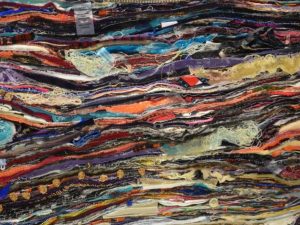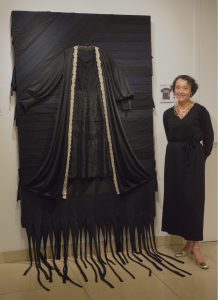
For nearly 15 years, fashion professor Kim Guthrie has been working with students to collect, trade, and dispose of fabric scarps, saving them from a growing mountain of textile waste. They started by placing collection bins in the fashion department, which quickly filled with more than a ton of textile waste.
Guthrie then developed Pop Up Stop to weave in an education and outreach component. She partnered with local organizations around Richmond to place additional collection bins, giving members of the community a way to dispose of unusable textiles.
By last year, however, Guthrie was looking to make a bolder statement.
The U.S. alone generates 13 million tons of textile waste annually, with the average garment being worn as few as seven times before being discarded. While donating unwanted clothes seems like a responsible alternative, in reality, about half of donated clothes aren’t suitable for resale. The rest are sent overseas, to landfills, or incinerated.
“I wanted to communicate the issues of textile waste in an unexpected, more provocative way,” she says. “I had this idea of uncovering fashion, of uncovering what’s really going on.
“So, I commissioned five of my colleagues to create a piece as a response to how they’re thinking about the global textile waste crisis.”
With the help of a VCUarts Dean’s Research Grant, Guthrie placed collection bins on campus at the Student Commons, SHIFT Retail Lab, and the Institute for Contemporary Art at VCU, as well as local businesses like Diversity Thrift, Topstich Mending, and Bluebones Vintage. They collected more than 700 pounds of fabric.
Once the spring 2025 semester ended, Guthrie and five other fashion faculty members—Cate Latham, Hawa Stwodah, Kevin Sellars, Jeannine Diego, and Michael Birch-Pierce—dumped everything on a table and started sorting by color.

Guthrie gravitated to black. She found three polyester dresses with lace work and other embellishments, as well as fully intact mid-century peignoir dressing gown. She combined them into a single dress—entitled Dead Dress—and mounted them to a canvas covered in strips of black t-shirts.
“It’s called Dead Dress because, to me, people are letting their clothes die,” she says. “But those three dead dresses are now living together in a different way. I wanted to rescue the prettiness of them.”
The UNCOVERING Fashion exhibition was on display in Richmond’s Main Street Station gallery in October, bringing their conversation about textile waste and alternative reuse to the public. Guthrie hopes visitors were inspired to consider their own behaviors around consumption and waste.
“I’m always overwhelmed by how much is all around us, all the time—whether it’s digital or tactile,” she says. “I will fashion wasn’t overproduced, that we threw less away, that people see the value in all types of objects that we ‘acquire.’
“I want to find ways for people to pause and think differently, even just for a minute or two.”